Legal Framework: Australian Law Questions and Answer Analysis
VerifiedAdded on 2020/06/04
|15
|4947
|36
Homework Assignment
AI Summary
This assignment provides a comprehensive overview of the Australian legal framework through a question-and-answer format. It covers a range of topics, including the reception of English law, the impact of the Colonial Laws Validity Act 1865, and the structure of the current parliament. The document explores legal concepts such as ratio decidendi, obiter dicta, precedents, and ultra vires, alongside the importance of proof and distinguishing in court. It also analyzes the landmark case of Donoghue v Stevenson and the process of legislation, including the roles of enacted and unenacted law. The assignment further delves into delegated legislation, jurisdiction, and the differences between civil and criminal law. Additionally, it examines the components of a statute, statutory interpretation, and the legal requirements for business structures. The document is a valuable resource for understanding the complexities of Australian law.
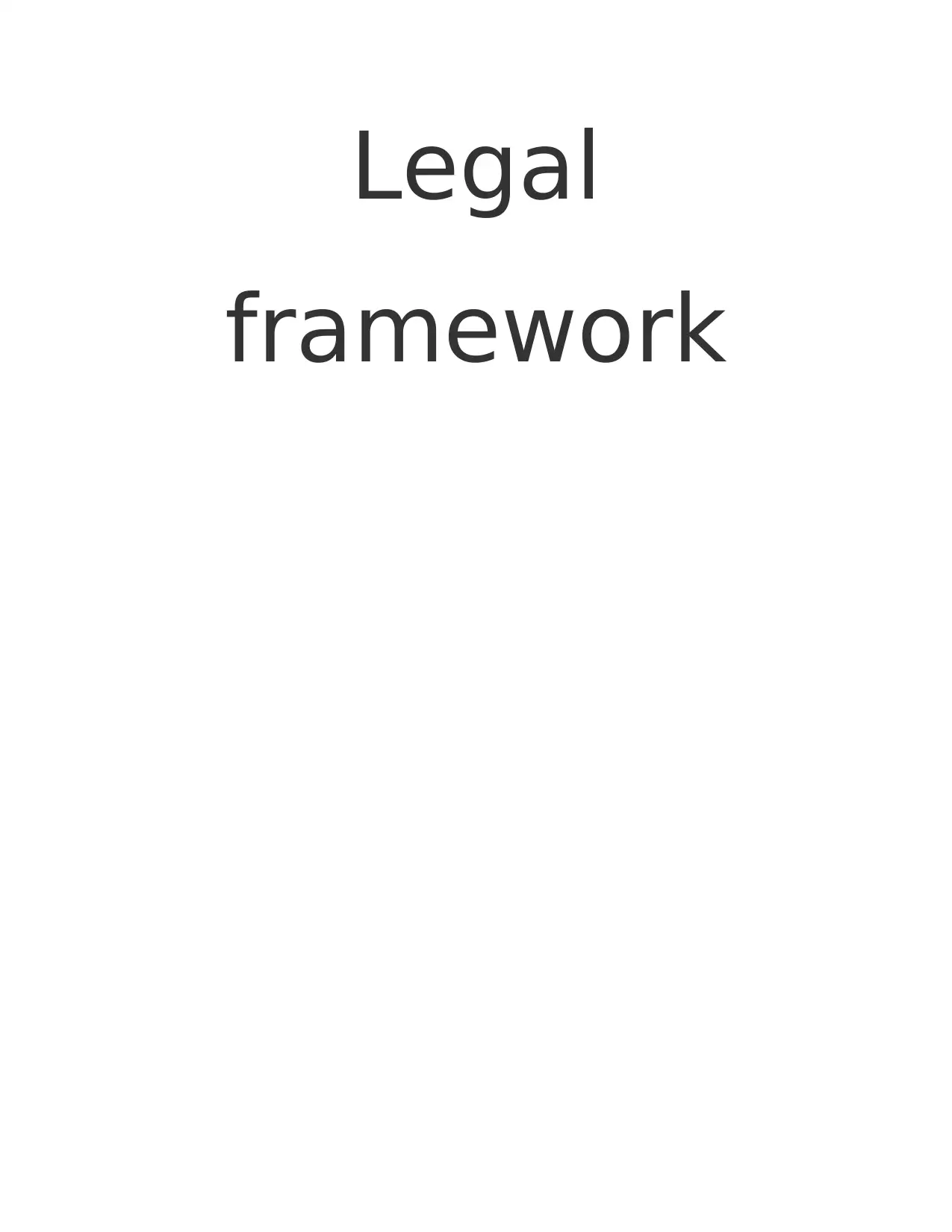
Legal
framework
framework
Paraphrase This Document
Need a fresh take? Get an instant paraphrase of this document with our AI Paraphraser
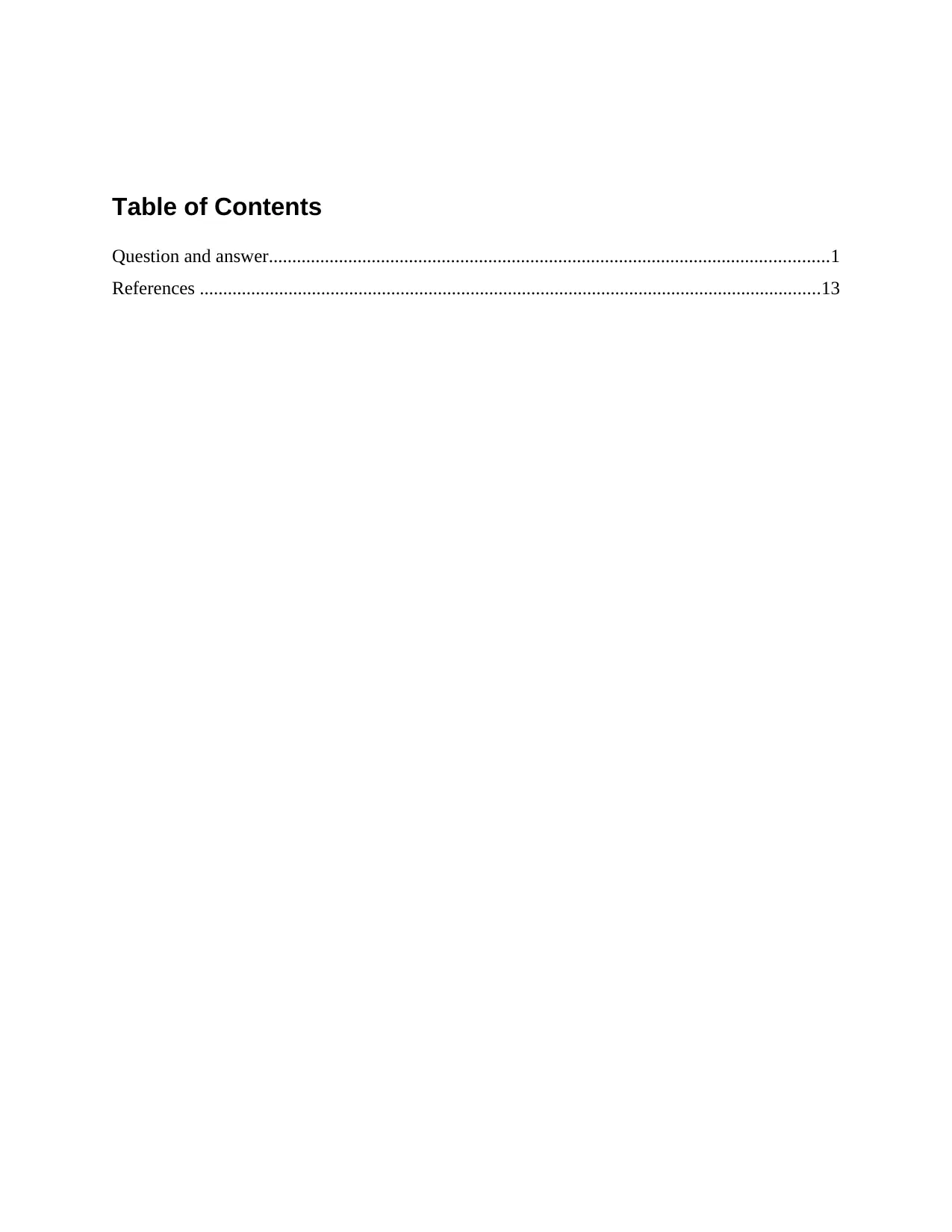
Table of Contents
Question and answer........................................................................................................................1
References .....................................................................................................................................13
Question and answer........................................................................................................................1
References .....................................................................................................................................13
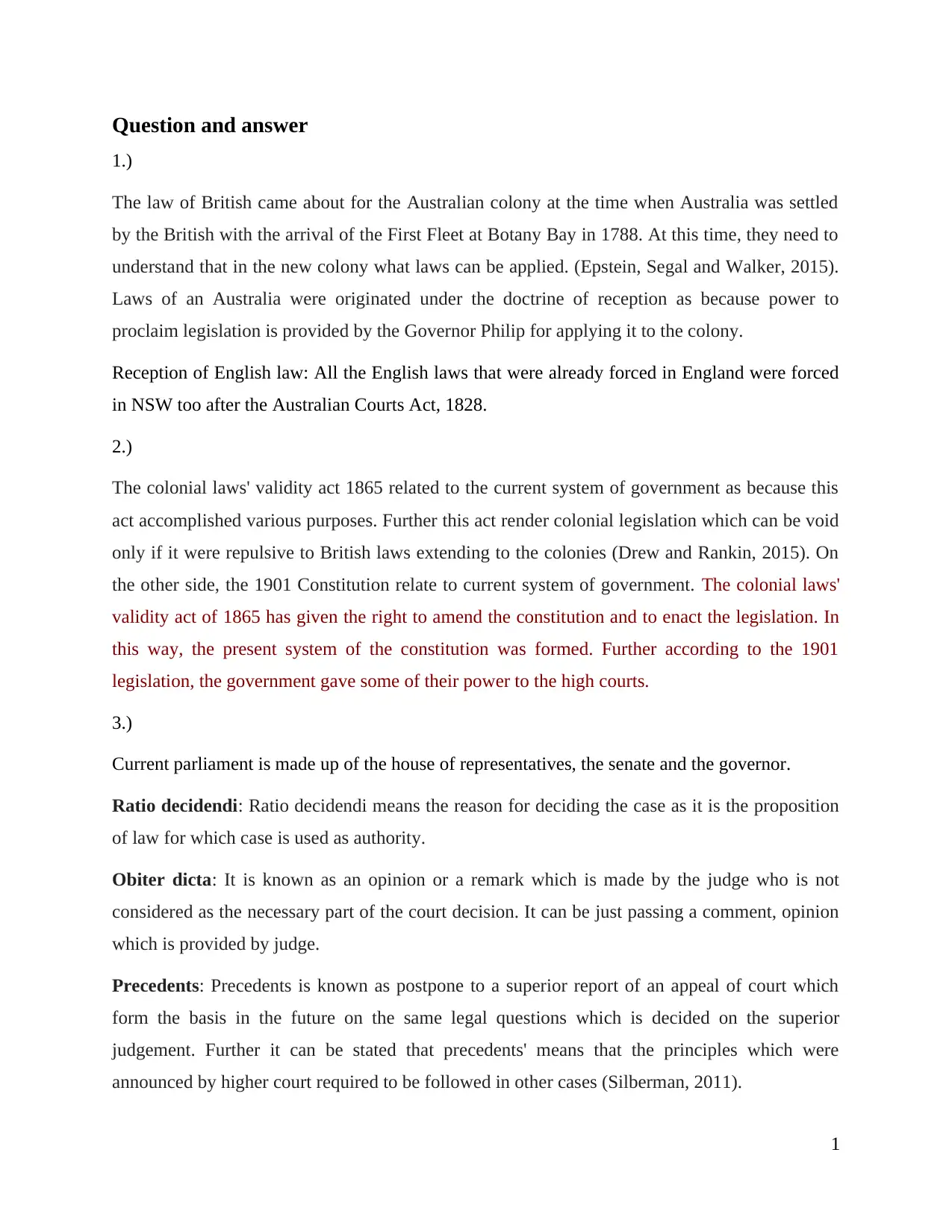
Question and answer
1.)
The law of British came about for the Australian colony at the time when Australia was settled
by the British with the arrival of the First Fleet at Botany Bay in 1788. At this time, they need to
understand that in the new colony what laws can be applied. (Epstein, Segal and Walker, 2015).
Laws of an Australia were originated under the doctrine of reception as because power to
proclaim legislation is provided by the Governor Philip for applying it to the colony.
Reception of English law: All the English laws that were already forced in England were forced
in NSW too after the Australian Courts Act, 1828.
2.)
The colonial laws' validity act 1865 related to the current system of government as because this
act accomplished various purposes. Further this act render colonial legislation which can be void
only if it were repulsive to British laws extending to the colonies (Drew and Rankin, 2015). On
the other side, the 1901 Constitution relate to current system of government. The colonial laws'
validity act of 1865 has given the right to amend the constitution and to enact the legislation. In
this way, the present system of the constitution was formed. Further according to the 1901
legislation, the government gave some of their power to the high courts.
3.)
Current parliament is made up of the house of representatives, the senate and the governor.
Ratio decidendi: Ratio decidendi means the reason for deciding the case as it is the proposition
of law for which case is used as authority.
Obiter dicta: It is known as an opinion or a remark which is made by the judge who is not
considered as the necessary part of the court decision. It can be just passing a comment, opinion
which is provided by judge.
Precedents: Precedents is known as postpone to a superior report of an appeal of court which
form the basis in the future on the same legal questions which is decided on the superior
judgement. Further it can be stated that precedents' means that the principles which were
announced by higher court required to be followed in other cases (Silberman, 2011).
1
1.)
The law of British came about for the Australian colony at the time when Australia was settled
by the British with the arrival of the First Fleet at Botany Bay in 1788. At this time, they need to
understand that in the new colony what laws can be applied. (Epstein, Segal and Walker, 2015).
Laws of an Australia were originated under the doctrine of reception as because power to
proclaim legislation is provided by the Governor Philip for applying it to the colony.
Reception of English law: All the English laws that were already forced in England were forced
in NSW too after the Australian Courts Act, 1828.
2.)
The colonial laws' validity act 1865 related to the current system of government as because this
act accomplished various purposes. Further this act render colonial legislation which can be void
only if it were repulsive to British laws extending to the colonies (Drew and Rankin, 2015). On
the other side, the 1901 Constitution relate to current system of government. The colonial laws'
validity act of 1865 has given the right to amend the constitution and to enact the legislation. In
this way, the present system of the constitution was formed. Further according to the 1901
legislation, the government gave some of their power to the high courts.
3.)
Current parliament is made up of the house of representatives, the senate and the governor.
Ratio decidendi: Ratio decidendi means the reason for deciding the case as it is the proposition
of law for which case is used as authority.
Obiter dicta: It is known as an opinion or a remark which is made by the judge who is not
considered as the necessary part of the court decision. It can be just passing a comment, opinion
which is provided by judge.
Precedents: Precedents is known as postpone to a superior report of an appeal of court which
form the basis in the future on the same legal questions which is decided on the superior
judgement. Further it can be stated that precedents' means that the principles which were
announced by higher court required to be followed in other cases (Silberman, 2011).
1
⊘ This is a preview!⊘
Do you want full access?
Subscribe today to unlock all pages.

Trusted by 1+ million students worldwide
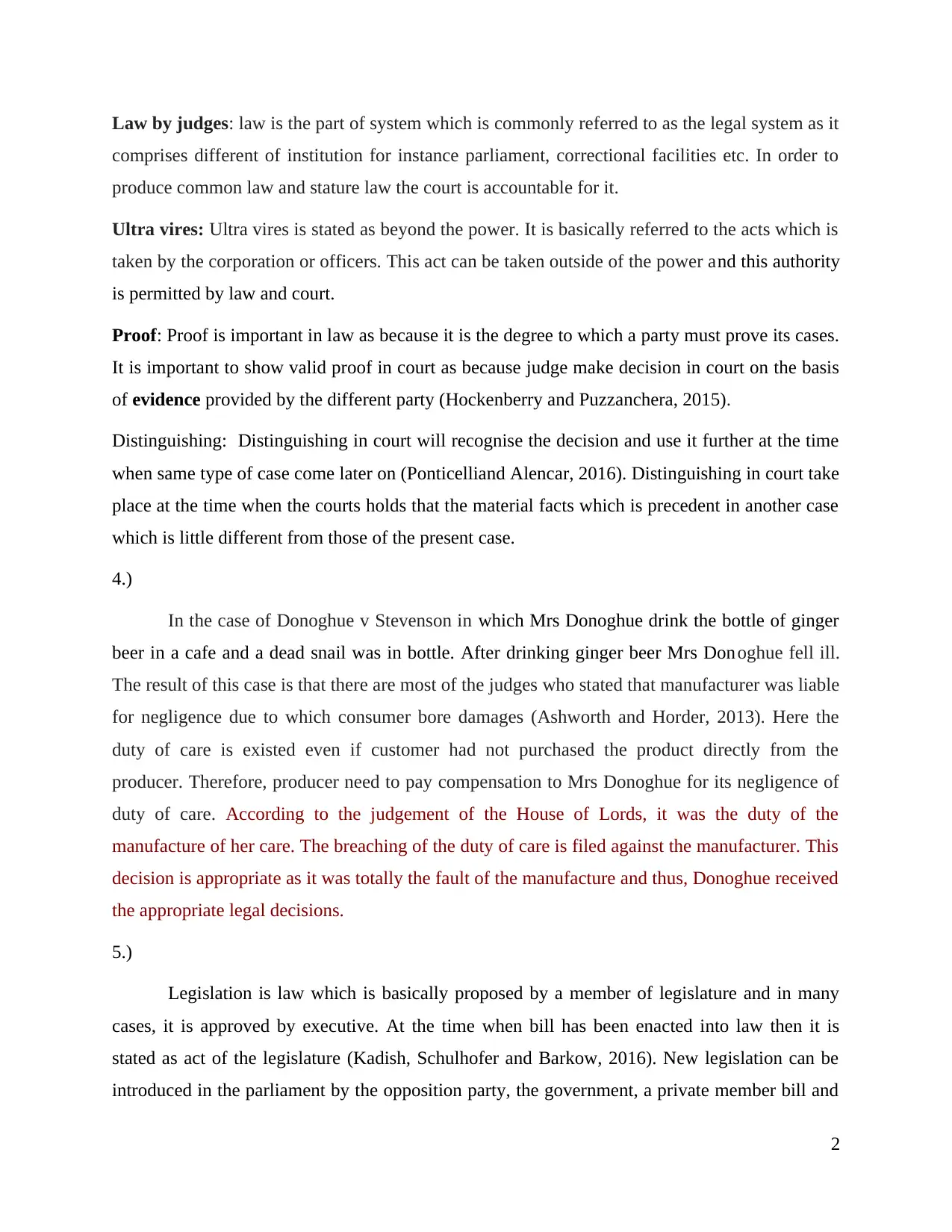
Law by judges: law is the part of system which is commonly referred to as the legal system as it
comprises different of institution for instance parliament, correctional facilities etc. In order to
produce common law and stature law the court is accountable for it.
Ultra vires: Ultra vires is stated as beyond the power. It is basically referred to the acts which is
taken by the corporation or officers. This act can be taken outside of the power and this authority
is permitted by law and court.
Proof: Proof is important in law as because it is the degree to which a party must prove its cases.
It is important to show valid proof in court as because judge make decision in court on the basis
of evidence provided by the different party (Hockenberry and Puzzanchera, 2015).
Distinguishing: Distinguishing in court will recognise the decision and use it further at the time
when same type of case come later on (Ponticelliand Alencar, 2016). Distinguishing in court take
place at the time when the courts holds that the material facts which is precedent in another case
which is little different from those of the present case.
4.)
In the case of Donoghue v Stevenson in which Mrs Donoghue drink the bottle of ginger
beer in a cafe and a dead snail was in bottle. After drinking ginger beer Mrs Donoghue fell ill.
The result of this case is that there are most of the judges who stated that manufacturer was liable
for negligence due to which consumer bore damages (Ashworth and Horder, 2013). Here the
duty of care is existed even if customer had not purchased the product directly from the
producer. Therefore, producer need to pay compensation to Mrs Donoghue for its negligence of
duty of care. According to the judgement of the House of Lords, it was the duty of the
manufacture of her care. The breaching of the duty of care is filed against the manufacturer. This
decision is appropriate as it was totally the fault of the manufacture and thus, Donoghue received
the appropriate legal decisions.
5.)
Legislation is law which is basically proposed by a member of legislature and in many
cases, it is approved by executive. At the time when bill has been enacted into law then it is
stated as act of the legislature (Kadish, Schulhofer and Barkow, 2016). New legislation can be
introduced in the parliament by the opposition party, the government, a private member bill and
2
comprises different of institution for instance parliament, correctional facilities etc. In order to
produce common law and stature law the court is accountable for it.
Ultra vires: Ultra vires is stated as beyond the power. It is basically referred to the acts which is
taken by the corporation or officers. This act can be taken outside of the power and this authority
is permitted by law and court.
Proof: Proof is important in law as because it is the degree to which a party must prove its cases.
It is important to show valid proof in court as because judge make decision in court on the basis
of evidence provided by the different party (Hockenberry and Puzzanchera, 2015).
Distinguishing: Distinguishing in court will recognise the decision and use it further at the time
when same type of case come later on (Ponticelliand Alencar, 2016). Distinguishing in court take
place at the time when the courts holds that the material facts which is precedent in another case
which is little different from those of the present case.
4.)
In the case of Donoghue v Stevenson in which Mrs Donoghue drink the bottle of ginger
beer in a cafe and a dead snail was in bottle. After drinking ginger beer Mrs Donoghue fell ill.
The result of this case is that there are most of the judges who stated that manufacturer was liable
for negligence due to which consumer bore damages (Ashworth and Horder, 2013). Here the
duty of care is existed even if customer had not purchased the product directly from the
producer. Therefore, producer need to pay compensation to Mrs Donoghue for its negligence of
duty of care. According to the judgement of the House of Lords, it was the duty of the
manufacture of her care. The breaching of the duty of care is filed against the manufacturer. This
decision is appropriate as it was totally the fault of the manufacture and thus, Donoghue received
the appropriate legal decisions.
5.)
Legislation is law which is basically proposed by a member of legislature and in many
cases, it is approved by executive. At the time when bill has been enacted into law then it is
stated as act of the legislature (Kadish, Schulhofer and Barkow, 2016). New legislation can be
introduced in the parliament by the opposition party, the government, a private member bill and
2
Paraphrase This Document
Need a fresh take? Get an instant paraphrase of this document with our AI Paraphraser
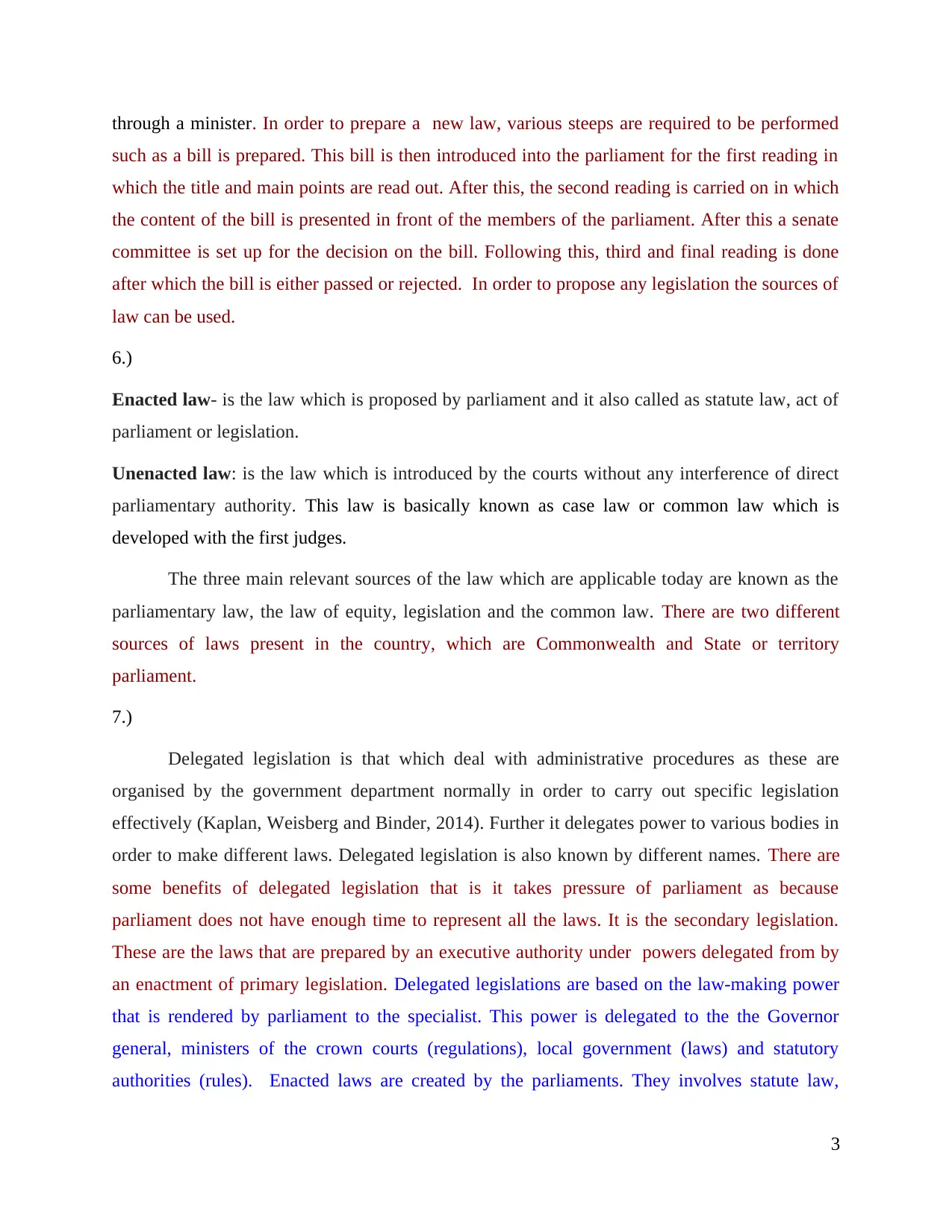
through a minister. In order to prepare a new law, various steeps are required to be performed
such as a bill is prepared. This bill is then introduced into the parliament for the first reading in
which the title and main points are read out. After this, the second reading is carried on in which
the content of the bill is presented in front of the members of the parliament. After this a senate
committee is set up for the decision on the bill. Following this, third and final reading is done
after which the bill is either passed or rejected. In order to propose any legislation the sources of
law can be used.
6.)
Enacted law- is the law which is proposed by parliament and it also called as statute law, act of
parliament or legislation.
Unenacted law: is the law which is introduced by the courts without any interference of direct
parliamentary authority. This law is basically known as case law or common law which is
developed with the first judges.
The three main relevant sources of the law which are applicable today are known as the
parliamentary law, the law of equity, legislation and the common law. There are two different
sources of laws present in the country, which are Commonwealth and State or territory
parliament.
7.)
Delegated legislation is that which deal with administrative procedures as these are
organised by the government department normally in order to carry out specific legislation
effectively (Kaplan, Weisberg and Binder, 2014). Further it delegates power to various bodies in
order to make different laws. Delegated legislation is also known by different names. There are
some benefits of delegated legislation that is it takes pressure of parliament as because
parliament does not have enough time to represent all the laws. It is the secondary legislation.
These are the laws that are prepared by an executive authority under powers delegated from by
an enactment of primary legislation. Delegated legislations are based on the law-making power
that is rendered by parliament to the specialist. This power is delegated to the the Governor
general, ministers of the crown courts (regulations), local government (laws) and statutory
authorities (rules). Enacted laws are created by the parliaments. They involves statute law,
3
such as a bill is prepared. This bill is then introduced into the parliament for the first reading in
which the title and main points are read out. After this, the second reading is carried on in which
the content of the bill is presented in front of the members of the parliament. After this a senate
committee is set up for the decision on the bill. Following this, third and final reading is done
after which the bill is either passed or rejected. In order to propose any legislation the sources of
law can be used.
6.)
Enacted law- is the law which is proposed by parliament and it also called as statute law, act of
parliament or legislation.
Unenacted law: is the law which is introduced by the courts without any interference of direct
parliamentary authority. This law is basically known as case law or common law which is
developed with the first judges.
The three main relevant sources of the law which are applicable today are known as the
parliamentary law, the law of equity, legislation and the common law. There are two different
sources of laws present in the country, which are Commonwealth and State or territory
parliament.
7.)
Delegated legislation is that which deal with administrative procedures as these are
organised by the government department normally in order to carry out specific legislation
effectively (Kaplan, Weisberg and Binder, 2014). Further it delegates power to various bodies in
order to make different laws. Delegated legislation is also known by different names. There are
some benefits of delegated legislation that is it takes pressure of parliament as because
parliament does not have enough time to represent all the laws. It is the secondary legislation.
These are the laws that are prepared by an executive authority under powers delegated from by
an enactment of primary legislation. Delegated legislations are based on the law-making power
that is rendered by parliament to the specialist. This power is delegated to the the Governor
general, ministers of the crown courts (regulations), local government (laws) and statutory
authorities (rules). Enacted laws are created by the parliaments. They involves statute law,
3
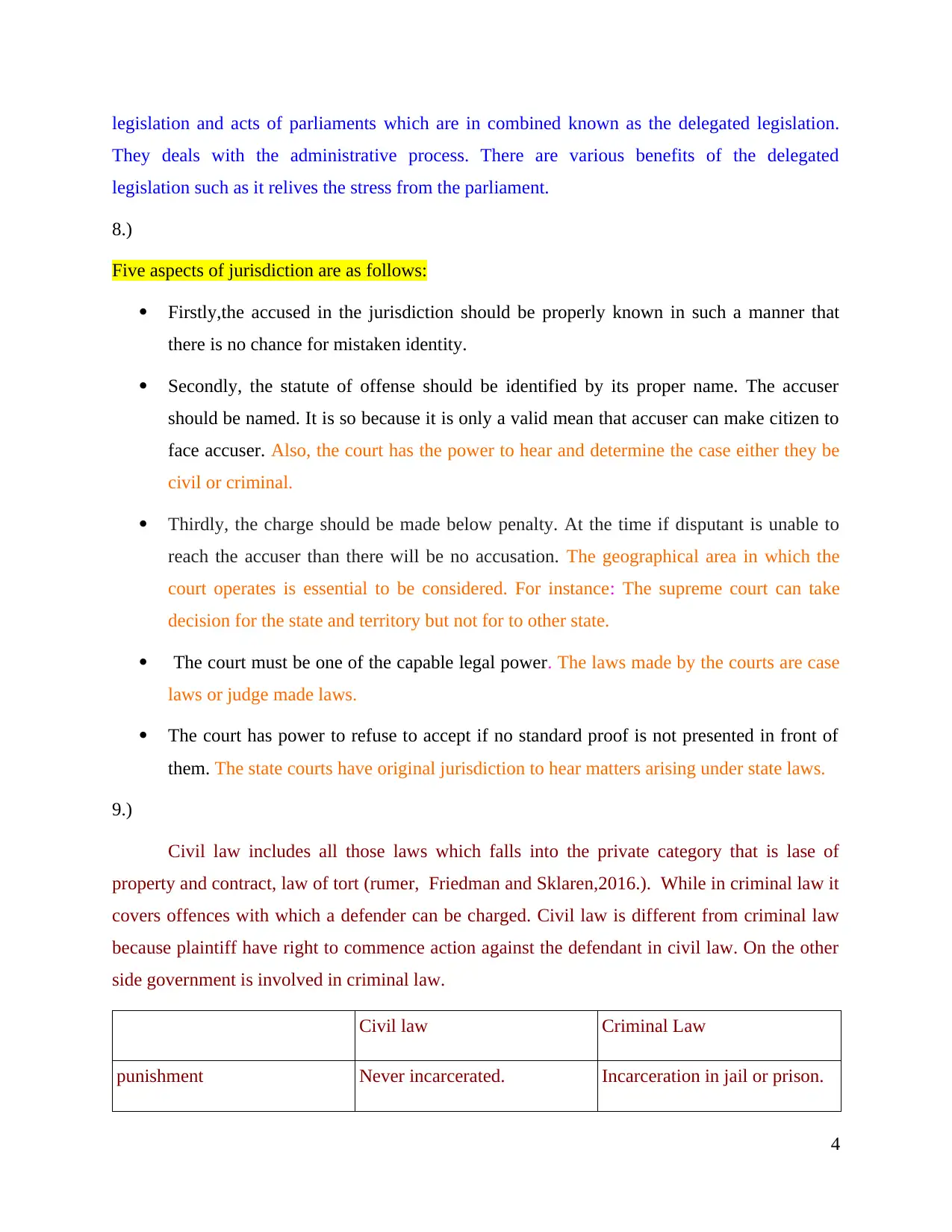
legislation and acts of parliaments which are in combined known as the delegated legislation.
They deals with the administrative process. There are various benefits of the delegated
legislation such as it relives the stress from the parliament.
8.)
Five aspects of jurisdiction are as follows:
Firstly,the accused in the jurisdiction should be properly known in such a manner that
there is no chance for mistaken identity.
Secondly, the statute of offense should be identified by its proper name. The accuser
should be named. It is so because it is only a valid mean that accuser can make citizen to
face accuser. Also, the court has the power to hear and determine the case either they be
civil or criminal.
Thirdly, the charge should be made below penalty. At the time if disputant is unable to
reach the accuser than there will be no accusation. The geographical area in which the
court operates is essential to be considered. For instance: The supreme court can take
decision for the state and territory but not for to other state.
The court must be one of the capable legal power. The laws made by the courts are case
laws or judge made laws.
The court has power to refuse to accept if no standard proof is not presented in front of
them. The state courts have original jurisdiction to hear matters arising under state laws.
9.)
Civil law includes all those laws which falls into the private category that is lase of
property and contract, law of tort (rumer, Friedman and Sklaren,2016.). While in criminal law it
covers offences with which a defender can be charged. Civil law is different from criminal law
because plaintiff have right to commence action against the defendant in civil law. On the other
side government is involved in criminal law.
Civil law Criminal Law
punishment Never incarcerated. Incarceration in jail or prison.
4
They deals with the administrative process. There are various benefits of the delegated
legislation such as it relives the stress from the parliament.
8.)
Five aspects of jurisdiction are as follows:
Firstly,the accused in the jurisdiction should be properly known in such a manner that
there is no chance for mistaken identity.
Secondly, the statute of offense should be identified by its proper name. The accuser
should be named. It is so because it is only a valid mean that accuser can make citizen to
face accuser. Also, the court has the power to hear and determine the case either they be
civil or criminal.
Thirdly, the charge should be made below penalty. At the time if disputant is unable to
reach the accuser than there will be no accusation. The geographical area in which the
court operates is essential to be considered. For instance: The supreme court can take
decision for the state and territory but not for to other state.
The court must be one of the capable legal power. The laws made by the courts are case
laws or judge made laws.
The court has power to refuse to accept if no standard proof is not presented in front of
them. The state courts have original jurisdiction to hear matters arising under state laws.
9.)
Civil law includes all those laws which falls into the private category that is lase of
property and contract, law of tort (rumer, Friedman and Sklaren,2016.). While in criminal law it
covers offences with which a defender can be charged. Civil law is different from criminal law
because plaintiff have right to commence action against the defendant in civil law. On the other
side government is involved in criminal law.
Civil law Criminal Law
punishment Never incarcerated. Incarceration in jail or prison.
4
⊘ This is a preview!⊘
Do you want full access?
Subscribe today to unlock all pages.

Trusted by 1+ million students worldwide
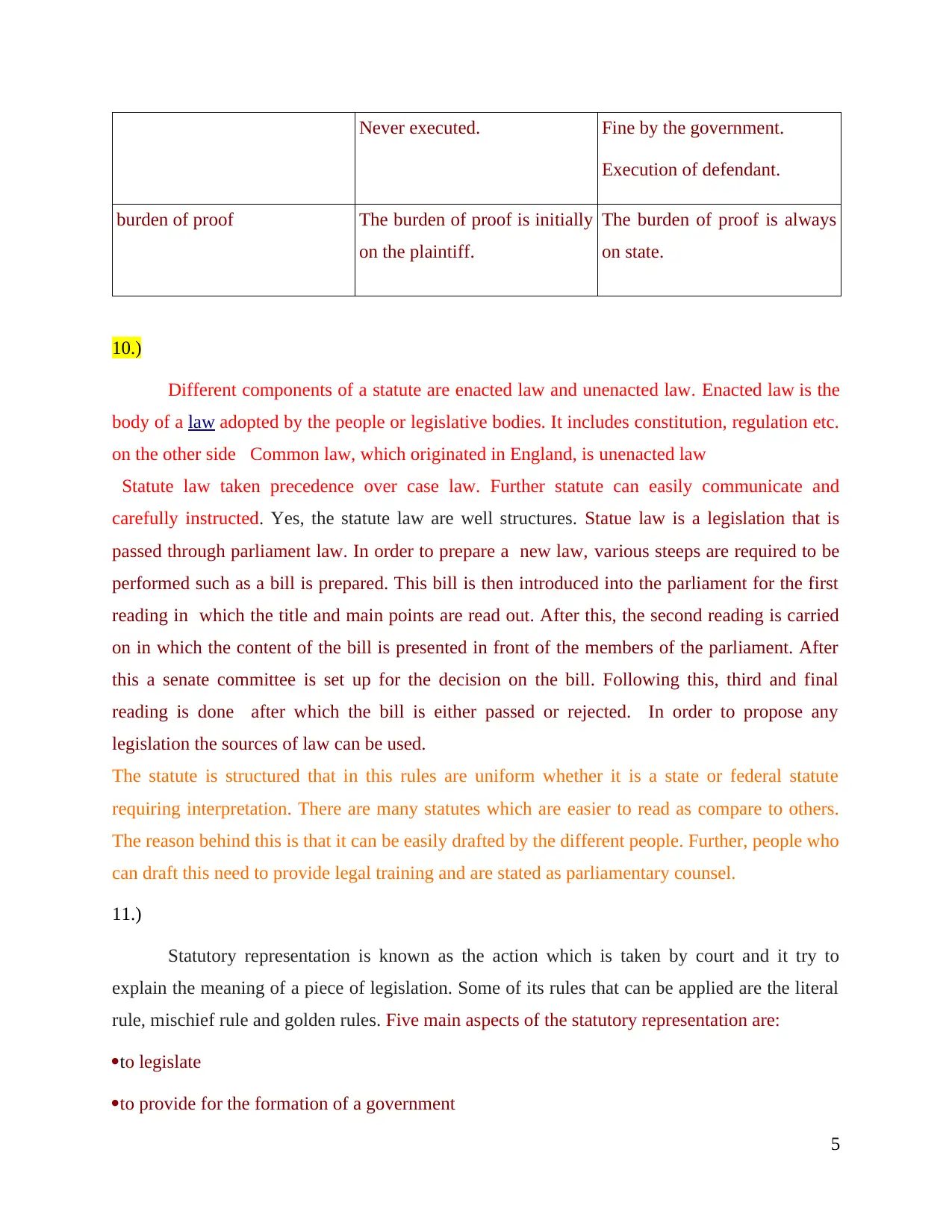
Never executed. Fine by the government.
Execution of defendant.
burden of proof The burden of proof is initially
on the plaintiff.
The burden of proof is always
on state.
10.)
Different components of a statute are enacted law and unenacted law. Enacted law is the
body of a law adopted by the people or legislative bodies. It includes constitution, regulation etc.
on the other side Common law, which originated in England, is unenacted law
Statute law taken precedence over case law. Further statute can easily communicate and
carefully instructed. Yes, the statute law are well structures. Statue law is a legislation that is
passed through parliament law. In order to prepare a new law, various steeps are required to be
performed such as a bill is prepared. This bill is then introduced into the parliament for the first
reading in which the title and main points are read out. After this, the second reading is carried
on in which the content of the bill is presented in front of the members of the parliament. After
this a senate committee is set up for the decision on the bill. Following this, third and final
reading is done after which the bill is either passed or rejected. In order to propose any
legislation the sources of law can be used.
The statute is structured that in this rules are uniform whether it is a state or federal statute
requiring interpretation. There are many statutes which are easier to read as compare to others.
The reason behind this is that it can be easily drafted by the different people. Further, people who
can draft this need to provide legal training and are stated as parliamentary counsel.
11.)
Statutory representation is known as the action which is taken by court and it try to
explain the meaning of a piece of legislation. Some of its rules that can be applied are the literal
rule, mischief rule and golden rules. Five main aspects of the statutory representation are:
to legislate
to provide for the formation of a government
5
Execution of defendant.
burden of proof The burden of proof is initially
on the plaintiff.
The burden of proof is always
on state.
10.)
Different components of a statute are enacted law and unenacted law. Enacted law is the
body of a law adopted by the people or legislative bodies. It includes constitution, regulation etc.
on the other side Common law, which originated in England, is unenacted law
Statute law taken precedence over case law. Further statute can easily communicate and
carefully instructed. Yes, the statute law are well structures. Statue law is a legislation that is
passed through parliament law. In order to prepare a new law, various steeps are required to be
performed such as a bill is prepared. This bill is then introduced into the parliament for the first
reading in which the title and main points are read out. After this, the second reading is carried
on in which the content of the bill is presented in front of the members of the parliament. After
this a senate committee is set up for the decision on the bill. Following this, third and final
reading is done after which the bill is either passed or rejected. In order to propose any
legislation the sources of law can be used.
The statute is structured that in this rules are uniform whether it is a state or federal statute
requiring interpretation. There are many statutes which are easier to read as compare to others.
The reason behind this is that it can be easily drafted by the different people. Further, people who
can draft this need to provide legal training and are stated as parliamentary counsel.
11.)
Statutory representation is known as the action which is taken by court and it try to
explain the meaning of a piece of legislation. Some of its rules that can be applied are the literal
rule, mischief rule and golden rules. Five main aspects of the statutory representation are:
to legislate
to provide for the formation of a government
5
Paraphrase This Document
Need a fresh take? Get an instant paraphrase of this document with our AI Paraphraser
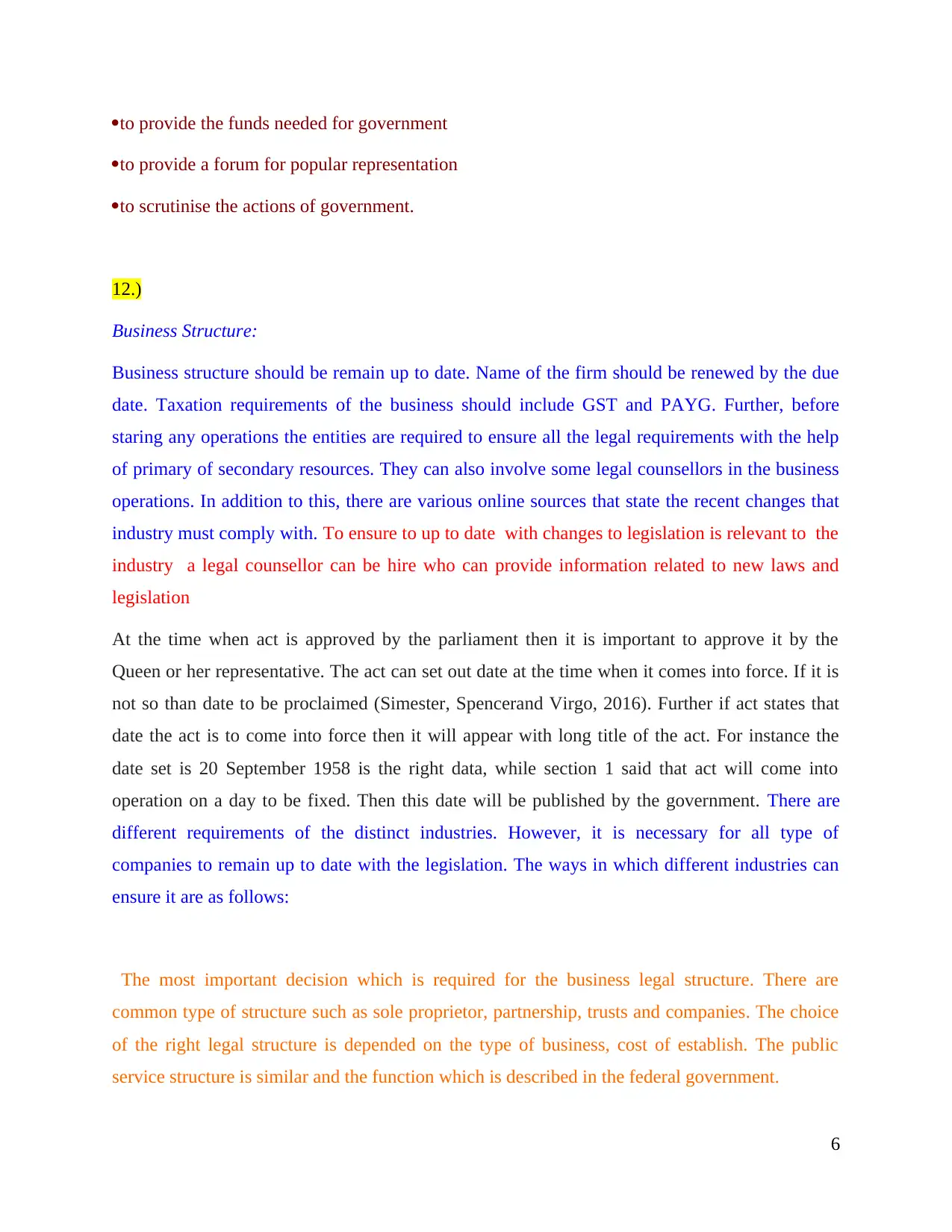
to provide the funds needed for government
to provide a forum for popular representation
to scrutinise the actions of government.
12.)
Business Structure:
Business structure should be remain up to date. Name of the firm should be renewed by the due
date. Taxation requirements of the business should include GST and PAYG. Further, before
staring any operations the entities are required to ensure all the legal requirements with the help
of primary of secondary resources. They can also involve some legal counsellors in the business
operations. In addition to this, there are various online sources that state the recent changes that
industry must comply with. To ensure to up to date with changes to legislation is relevant to the
industry a legal counsellor can be hire who can provide information related to new laws and
legislation
At the time when act is approved by the parliament then it is important to approve it by the
Queen or her representative. The act can set out date at the time when it comes into force. If it is
not so than date to be proclaimed (Simester, Spencerand Virgo, 2016). Further if act states that
date the act is to come into force then it will appear with long title of the act. For instance the
date set is 20 September 1958 is the right data, while section 1 said that act will come into
operation on a day to be fixed. Then this date will be published by the government. There are
different requirements of the distinct industries. However, it is necessary for all type of
companies to remain up to date with the legislation. The ways in which different industries can
ensure it are as follows:
The most important decision which is required for the business legal structure. There are
common type of structure such as sole proprietor, partnership, trusts and companies. The choice
of the right legal structure is depended on the type of business, cost of establish. The public
service structure is similar and the function which is described in the federal government.
6
to provide a forum for popular representation
to scrutinise the actions of government.
12.)
Business Structure:
Business structure should be remain up to date. Name of the firm should be renewed by the due
date. Taxation requirements of the business should include GST and PAYG. Further, before
staring any operations the entities are required to ensure all the legal requirements with the help
of primary of secondary resources. They can also involve some legal counsellors in the business
operations. In addition to this, there are various online sources that state the recent changes that
industry must comply with. To ensure to up to date with changes to legislation is relevant to the
industry a legal counsellor can be hire who can provide information related to new laws and
legislation
At the time when act is approved by the parliament then it is important to approve it by the
Queen or her representative. The act can set out date at the time when it comes into force. If it is
not so than date to be proclaimed (Simester, Spencerand Virgo, 2016). Further if act states that
date the act is to come into force then it will appear with long title of the act. For instance the
date set is 20 September 1958 is the right data, while section 1 said that act will come into
operation on a day to be fixed. Then this date will be published by the government. There are
different requirements of the distinct industries. However, it is necessary for all type of
companies to remain up to date with the legislation. The ways in which different industries can
ensure it are as follows:
The most important decision which is required for the business legal structure. There are
common type of structure such as sole proprietor, partnership, trusts and companies. The choice
of the right legal structure is depended on the type of business, cost of establish. The public
service structure is similar and the function which is described in the federal government.
6
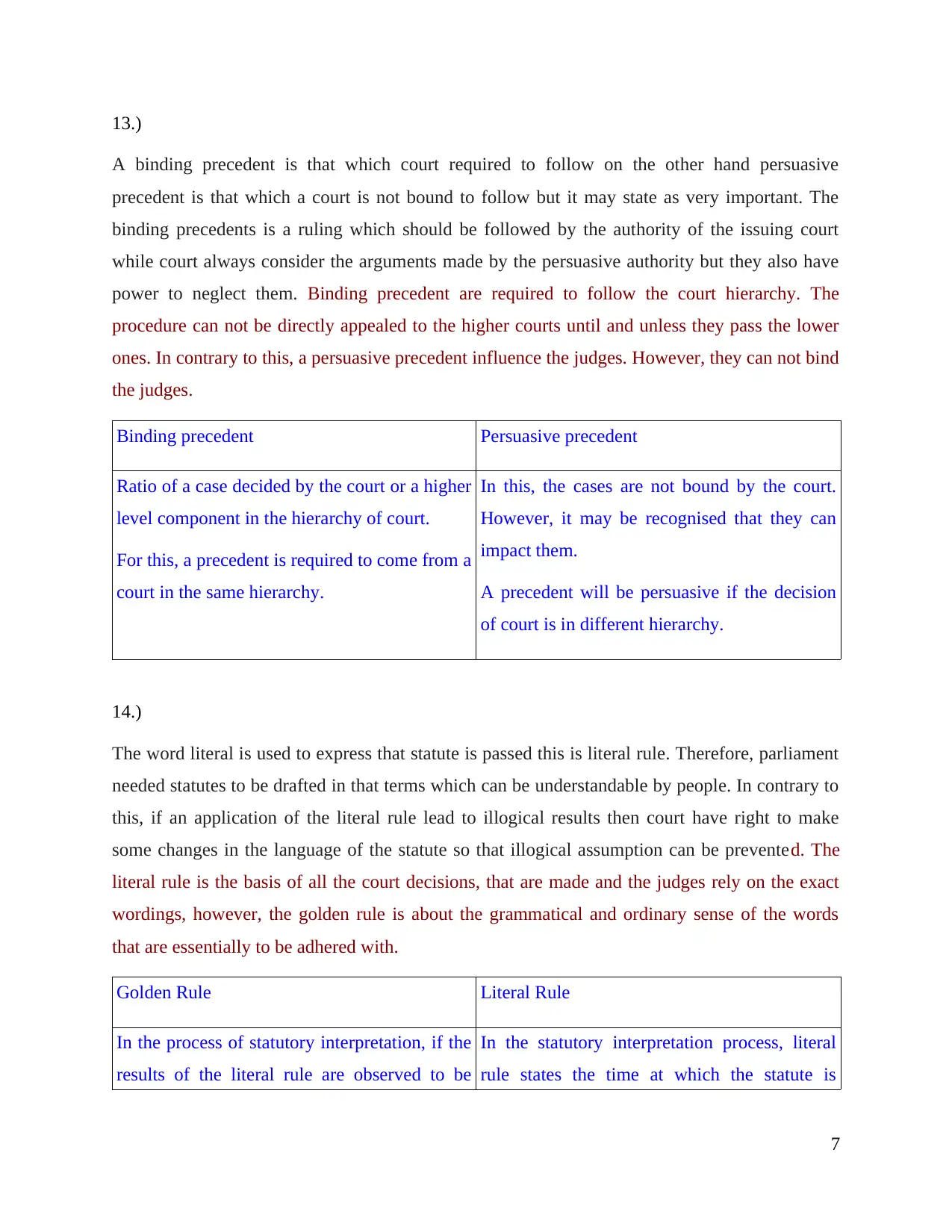
13.)
A binding precedent is that which court required to follow on the other hand persuasive
precedent is that which a court is not bound to follow but it may state as very important. The
binding precedents is a ruling which should be followed by the authority of the issuing court
while court always consider the arguments made by the persuasive authority but they also have
power to neglect them. Binding precedent are required to follow the court hierarchy. The
procedure can not be directly appealed to the higher courts until and unless they pass the lower
ones. In contrary to this, a persuasive precedent influence the judges. However, they can not bind
the judges.
Binding precedent Persuasive precedent
Ratio of a case decided by the court or a higher
level component in the hierarchy of court.
For this, a precedent is required to come from a
court in the same hierarchy.
In this, the cases are not bound by the court.
However, it may be recognised that they can
impact them.
A precedent will be persuasive if the decision
of court is in different hierarchy.
14.)
The word literal is used to express that statute is passed this is literal rule. Therefore, parliament
needed statutes to be drafted in that terms which can be understandable by people. In contrary to
this, if an application of the literal rule lead to illogical results then court have right to make
some changes in the language of the statute so that illogical assumption can be prevented. The
literal rule is the basis of all the court decisions, that are made and the judges rely on the exact
wordings, however, the golden rule is about the grammatical and ordinary sense of the words
that are essentially to be adhered with.
Golden Rule Literal Rule
In the process of statutory interpretation, if the
results of the literal rule are observed to be
In the statutory interpretation process, literal
rule states the time at which the statute is
7
A binding precedent is that which court required to follow on the other hand persuasive
precedent is that which a court is not bound to follow but it may state as very important. The
binding precedents is a ruling which should be followed by the authority of the issuing court
while court always consider the arguments made by the persuasive authority but they also have
power to neglect them. Binding precedent are required to follow the court hierarchy. The
procedure can not be directly appealed to the higher courts until and unless they pass the lower
ones. In contrary to this, a persuasive precedent influence the judges. However, they can not bind
the judges.
Binding precedent Persuasive precedent
Ratio of a case decided by the court or a higher
level component in the hierarchy of court.
For this, a precedent is required to come from a
court in the same hierarchy.
In this, the cases are not bound by the court.
However, it may be recognised that they can
impact them.
A precedent will be persuasive if the decision
of court is in different hierarchy.
14.)
The word literal is used to express that statute is passed this is literal rule. Therefore, parliament
needed statutes to be drafted in that terms which can be understandable by people. In contrary to
this, if an application of the literal rule lead to illogical results then court have right to make
some changes in the language of the statute so that illogical assumption can be prevented. The
literal rule is the basis of all the court decisions, that are made and the judges rely on the exact
wordings, however, the golden rule is about the grammatical and ordinary sense of the words
that are essentially to be adhered with.
Golden Rule Literal Rule
In the process of statutory interpretation, if the
results of the literal rule are observed to be
In the statutory interpretation process, literal
rule states the time at which the statute is
7
⊘ This is a preview!⊘
Do you want full access?
Subscribe today to unlock all pages.

Trusted by 1+ million students worldwide
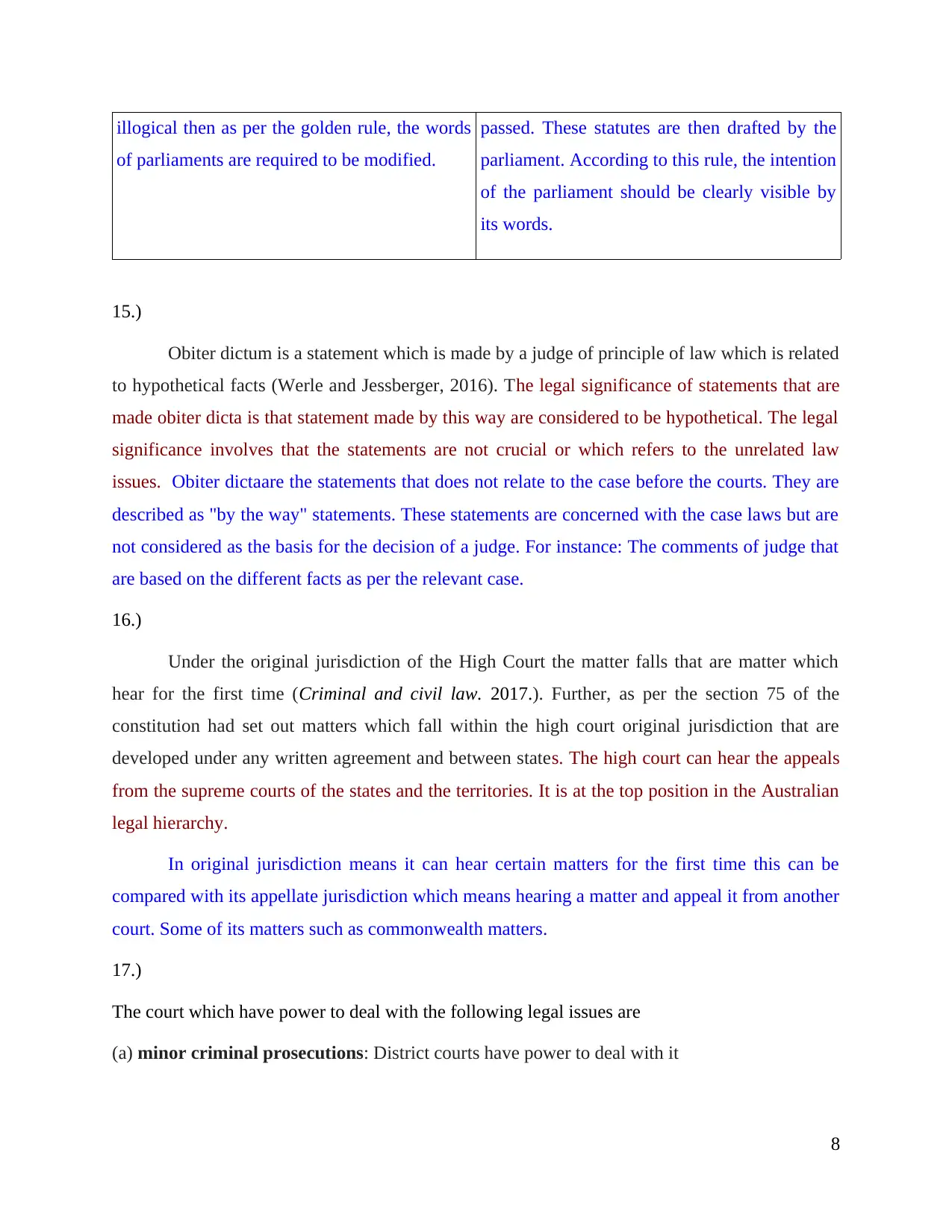
illogical then as per the golden rule, the words
of parliaments are required to be modified.
passed. These statutes are then drafted by the
parliament. According to this rule, the intention
of the parliament should be clearly visible by
its words.
15.)
Obiter dictum is a statement which is made by a judge of principle of law which is related
to hypothetical facts (Werle and Jessberger, 2016). The legal significance of statements that are
made obiter dicta is that statement made by this way are considered to be hypothetical. The legal
significance involves that the statements are not crucial or which refers to the unrelated law
issues. Obiter dictaare the statements that does not relate to the case before the courts. They are
described as "by the way" statements. These statements are concerned with the case laws but are
not considered as the basis for the decision of a judge. For instance: The comments of judge that
are based on the different facts as per the relevant case.
16.)
Under the original jurisdiction of the High Court the matter falls that are matter which
hear for the first time (Criminal and civil law. 2017.). Further, as per the section 75 of the
constitution had set out matters which fall within the high court original jurisdiction that are
developed under any written agreement and between states. The high court can hear the appeals
from the supreme courts of the states and the territories. It is at the top position in the Australian
legal hierarchy.
In original jurisdiction means it can hear certain matters for the first time this can be
compared with its appellate jurisdiction which means hearing a matter and appeal it from another
court. Some of its matters such as commonwealth matters.
17.)
The court which have power to deal with the following legal issues are
(a) minor criminal prosecutions: District courts have power to deal with it
8
of parliaments are required to be modified.
passed. These statutes are then drafted by the
parliament. According to this rule, the intention
of the parliament should be clearly visible by
its words.
15.)
Obiter dictum is a statement which is made by a judge of principle of law which is related
to hypothetical facts (Werle and Jessberger, 2016). The legal significance of statements that are
made obiter dicta is that statement made by this way are considered to be hypothetical. The legal
significance involves that the statements are not crucial or which refers to the unrelated law
issues. Obiter dictaare the statements that does not relate to the case before the courts. They are
described as "by the way" statements. These statements are concerned with the case laws but are
not considered as the basis for the decision of a judge. For instance: The comments of judge that
are based on the different facts as per the relevant case.
16.)
Under the original jurisdiction of the High Court the matter falls that are matter which
hear for the first time (Criminal and civil law. 2017.). Further, as per the section 75 of the
constitution had set out matters which fall within the high court original jurisdiction that are
developed under any written agreement and between states. The high court can hear the appeals
from the supreme courts of the states and the territories. It is at the top position in the Australian
legal hierarchy.
In original jurisdiction means it can hear certain matters for the first time this can be
compared with its appellate jurisdiction which means hearing a matter and appeal it from another
court. Some of its matters such as commonwealth matters.
17.)
The court which have power to deal with the following legal issues are
(a) minor criminal prosecutions: District courts have power to deal with it
8
Paraphrase This Document
Need a fresh take? Get an instant paraphrase of this document with our AI Paraphraser
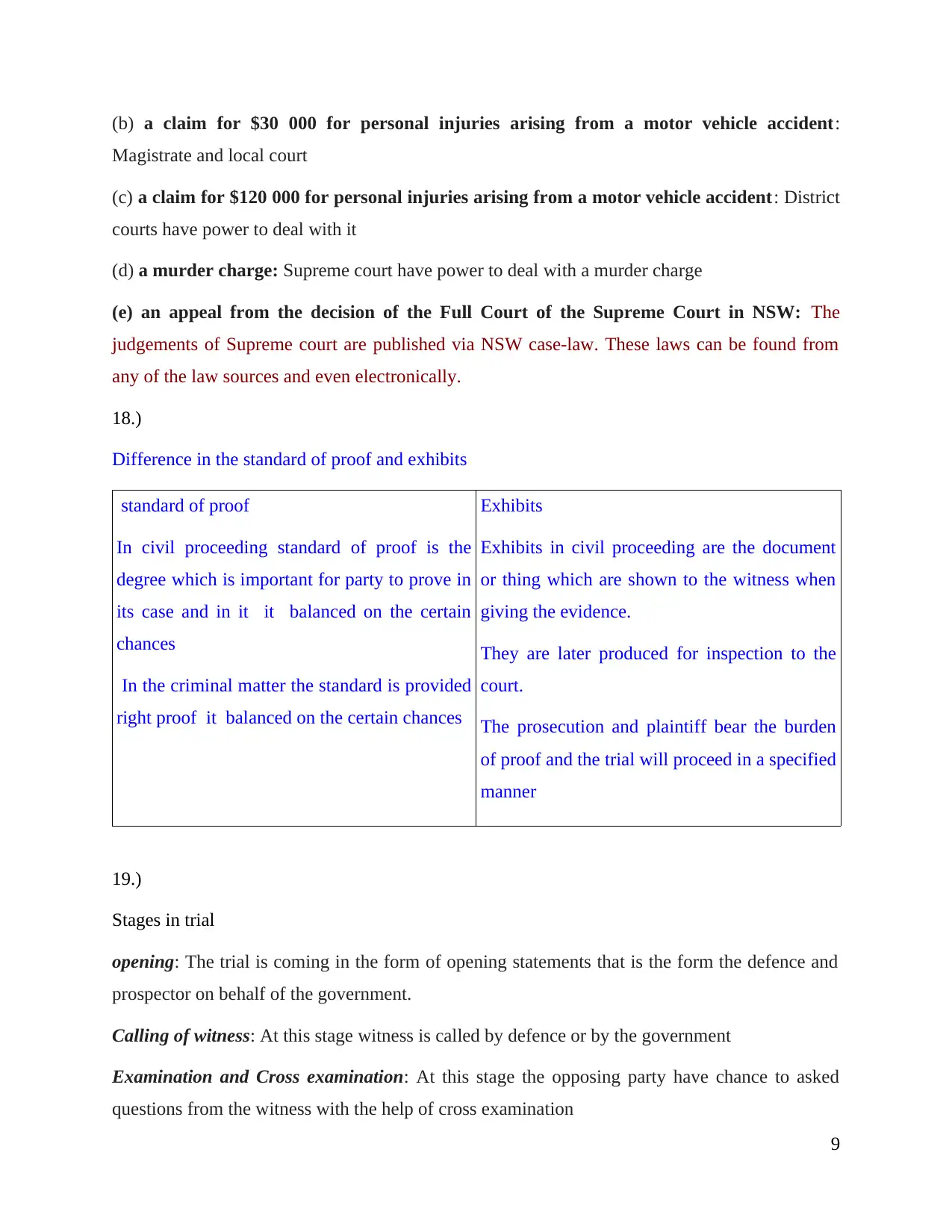
(b) a claim for $30 000 for personal injuries arising from a motor vehicle accident:
Magistrate and local court
(c) a claim for $120 000 for personal injuries arising from a motor vehicle accident: District
courts have power to deal with it
(d) a murder charge: Supreme court have power to deal with a murder charge
(e) an appeal from the decision of the Full Court of the Supreme Court in NSW: The
judgements of Supreme court are published via NSW case-law. These laws can be found from
any of the law sources and even electronically.
18.)
Difference in the standard of proof and exhibits
standard of proof
In civil proceeding standard of proof is the
degree which is important for party to prove in
its case and in it it balanced on the certain
chances
In the criminal matter the standard is provided
right proof it balanced on the certain chances
Exhibits
Exhibits in civil proceeding are the document
or thing which are shown to the witness when
giving the evidence.
They are later produced for inspection to the
court.
The prosecution and plaintiff bear the burden
of proof and the trial will proceed in a specified
manner
19.)
Stages in trial
opening: The trial is coming in the form of opening statements that is the form the defence and
prospector on behalf of the government.
Calling of witness: At this stage witness is called by defence or by the government
Examination and Cross examination: At this stage the opposing party have chance to asked
questions from the witness with the help of cross examination
9
Magistrate and local court
(c) a claim for $120 000 for personal injuries arising from a motor vehicle accident: District
courts have power to deal with it
(d) a murder charge: Supreme court have power to deal with a murder charge
(e) an appeal from the decision of the Full Court of the Supreme Court in NSW: The
judgements of Supreme court are published via NSW case-law. These laws can be found from
any of the law sources and even electronically.
18.)
Difference in the standard of proof and exhibits
standard of proof
In civil proceeding standard of proof is the
degree which is important for party to prove in
its case and in it it balanced on the certain
chances
In the criminal matter the standard is provided
right proof it balanced on the certain chances
Exhibits
Exhibits in civil proceeding are the document
or thing which are shown to the witness when
giving the evidence.
They are later produced for inspection to the
court.
The prosecution and plaintiff bear the burden
of proof and the trial will proceed in a specified
manner
19.)
Stages in trial
opening: The trial is coming in the form of opening statements that is the form the defence and
prospector on behalf of the government.
Calling of witness: At this stage witness is called by defence or by the government
Examination and Cross examination: At this stage the opposing party have chance to asked
questions from the witness with the help of cross examination
9
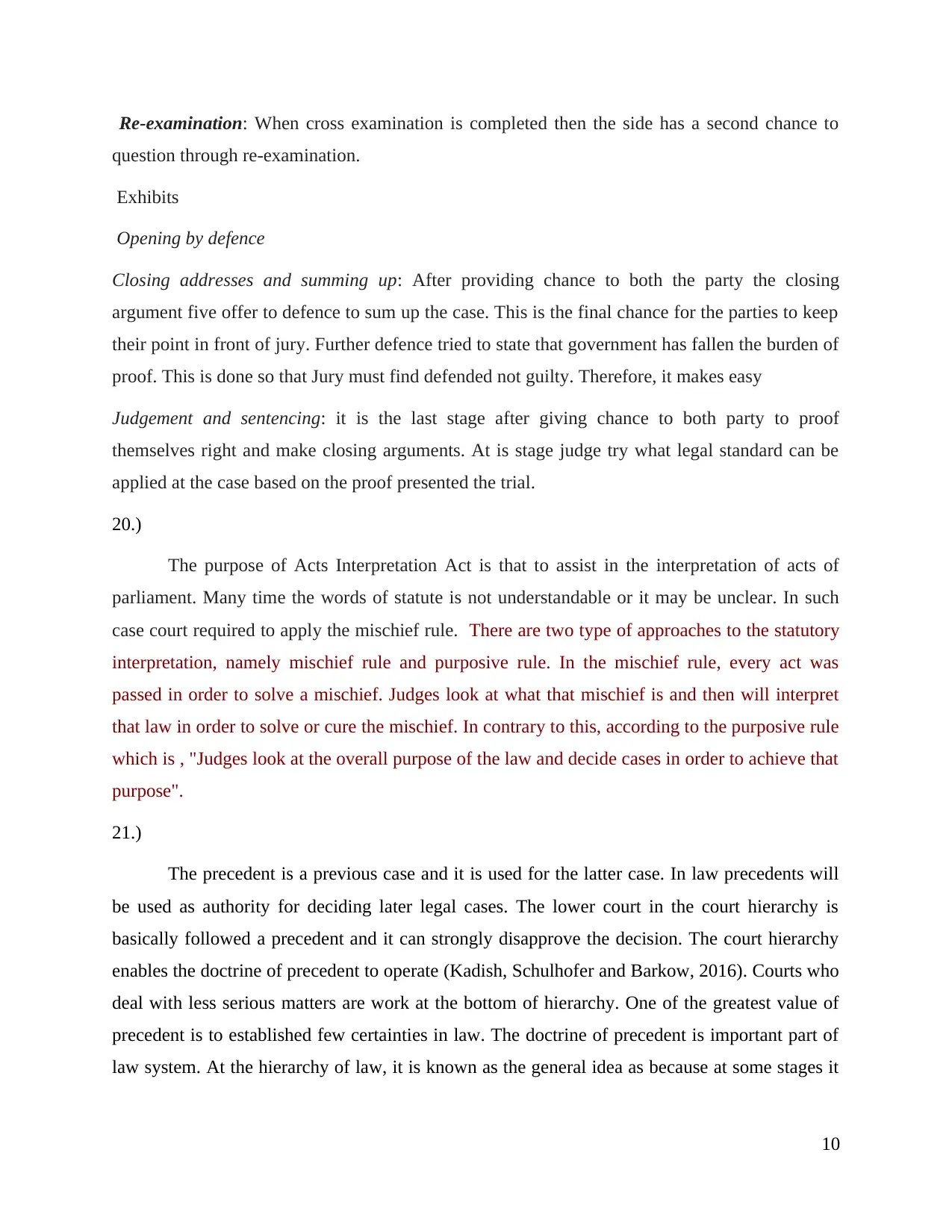
Re-examination: When cross examination is completed then the side has a second chance to
question through re-examination.
Exhibits
Opening by defence
Closing addresses and summing up: After providing chance to both the party the closing
argument five offer to defence to sum up the case. This is the final chance for the parties to keep
their point in front of jury. Further defence tried to state that government has fallen the burden of
proof. This is done so that Jury must find defended not guilty. Therefore, it makes easy
Judgement and sentencing: it is the last stage after giving chance to both party to proof
themselves right and make closing arguments. At is stage judge try what legal standard can be
applied at the case based on the proof presented the trial.
20.)
The purpose of Acts Interpretation Act is that to assist in the interpretation of acts of
parliament. Many time the words of statute is not understandable or it may be unclear. In such
case court required to apply the mischief rule. There are two type of approaches to the statutory
interpretation, namely mischief rule and purposive rule. In the mischief rule, every act was
passed in order to solve a mischief. Judges look at what that mischief is and then will interpret
that law in order to solve or cure the mischief. In contrary to this, according to the purposive rule
which is , "Judges look at the overall purpose of the law and decide cases in order to achieve that
purpose".
21.)
The precedent is a previous case and it is used for the latter case. In law precedents will
be used as authority for deciding later legal cases. The lower court in the court hierarchy is
basically followed a precedent and it can strongly disapprove the decision. The court hierarchy
enables the doctrine of precedent to operate (Kadish, Schulhofer and Barkow, 2016). Courts who
deal with less serious matters are work at the bottom of hierarchy. One of the greatest value of
precedent is to established few certainties in law. The doctrine of precedent is important part of
law system. At the hierarchy of law, it is known as the general idea as because at some stages it
10
question through re-examination.
Exhibits
Opening by defence
Closing addresses and summing up: After providing chance to both the party the closing
argument five offer to defence to sum up the case. This is the final chance for the parties to keep
their point in front of jury. Further defence tried to state that government has fallen the burden of
proof. This is done so that Jury must find defended not guilty. Therefore, it makes easy
Judgement and sentencing: it is the last stage after giving chance to both party to proof
themselves right and make closing arguments. At is stage judge try what legal standard can be
applied at the case based on the proof presented the trial.
20.)
The purpose of Acts Interpretation Act is that to assist in the interpretation of acts of
parliament. Many time the words of statute is not understandable or it may be unclear. In such
case court required to apply the mischief rule. There are two type of approaches to the statutory
interpretation, namely mischief rule and purposive rule. In the mischief rule, every act was
passed in order to solve a mischief. Judges look at what that mischief is and then will interpret
that law in order to solve or cure the mischief. In contrary to this, according to the purposive rule
which is , "Judges look at the overall purpose of the law and decide cases in order to achieve that
purpose".
21.)
The precedent is a previous case and it is used for the latter case. In law precedents will
be used as authority for deciding later legal cases. The lower court in the court hierarchy is
basically followed a precedent and it can strongly disapprove the decision. The court hierarchy
enables the doctrine of precedent to operate (Kadish, Schulhofer and Barkow, 2016). Courts who
deal with less serious matters are work at the bottom of hierarchy. One of the greatest value of
precedent is to established few certainties in law. The doctrine of precedent is important part of
law system. At the hierarchy of law, it is known as the general idea as because at some stages it
10
⊘ This is a preview!⊘
Do you want full access?
Subscribe today to unlock all pages.

Trusted by 1+ million students worldwide
1 out of 15
Related Documents
Your All-in-One AI-Powered Toolkit for Academic Success.
+13062052269
info@desklib.com
Available 24*7 on WhatsApp / Email
![[object Object]](/_next/static/media/star-bottom.7253800d.svg)
Unlock your academic potential
Copyright © 2020–2025 A2Z Services. All Rights Reserved. Developed and managed by ZUCOL.





